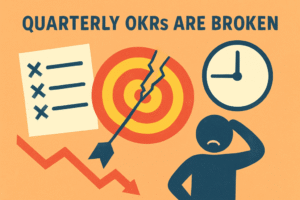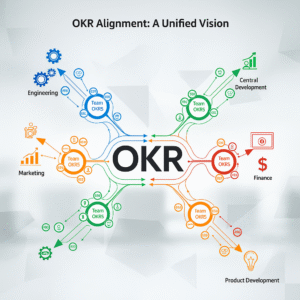Let’s talk about something that doesn’t always get the spotlight in strategic conversations but quietly erodes organizational performance: the cost of delivery. It’s easy to overlook. Budgets get approved. Work starts. Money gets spent. But as we look back at what it took to get something out the door, we realize it cost a lot more than we expected. Teams seem busier than ever, but the effort required to achieve results is disproportionately high. And as solutions grow in complexity, the cost of making any kind of change only increases.
This is the quiet problem of high delivery costs. And if you’re trying to build a more adaptive organization, it’s a problem you can’t afford to ignore. In fact, paradoxically, the pursuit of adaptability can sometimes make it worse.
Adaptability Isn’t Cheap
At least not the way most organizations approach it. Becoming adaptive means moving away from rigid plans and linear execution, and embracing change as part of how work gets done. That’s a good thing. But when you start shifting direction more frequently, introducing new priorities mid-flight, or trying to realign teams on the fly, you put stress on a system that may not have the flexibility to absorb that kind of motion. Every change in direction creates friction:
- New coordination overhead
- Rework on partially completed initiatives
- Delays due to conflicting priorities
- Overbooked experts and resource bottlenecks
These frictions don’t show up as line items on a budget. But they have a cost, and it adds up quickly. We often hear leaders say, “We’re moving too slow,” or “It feels like everything costs more than it should.” They’re right—but the problem isn’t speed or budget management. It’s structural inefficiency within the delivery system itself.
I remember working with a digital group of 14 teams. They brought in coaches to adopt an agile operating model and successfully and rapidly shifted from a once a year to monthly deployment model. While they were high-fiving their success they realized that the cost per release was ~$100k. By switching to a monthly release schedule without changing their release methods, the annual cost of release was now $1.2M… We scaled back frequency to quarterly as we addressed the dependencies and testing that was driving the cost up before gradually increasing the frequency again.
Delivery Is Harder Than It Looks
One of the more frustrating dynamics is that from a distance, things can look fine. Everyone’s busy. Teams are working hard. Planning meetings are happening. Roadmaps are filled in. But somehow, we still don’t feel like we’re getting the value we expect from the investment we’re making. This isn’t a performance problem—it’s a system problem. High delivery costs show up when:
- The coordination effort required to get something done is disproportionately high
- Small changes in one place cause big impacts in another
- Teams spend more time managing dependencies than delivering value
- Initiatives drag on, absorbing more and more capacity with diminishing returns
The work is getting done—but it’s costing more than it should.
The Cost of Change
One of the most telling signs of a high-cost environment is how difficult it becomes to change direction. It’s not that people aren’t willing—it’s that the system resists.
Want to pivot? That’ll require four other teams to change their plans.
Want to accelerate something? You’ll need to reassign already-stretched resources.
Want to stop something? You’ll lose sunk costs and potentially abandon half-built work. These trade-offs start to paralyze decision-making.
Leaders hesitate to try new things, not because the ideas are bad, but because the process of delivering anything has become so resource-intensive that it no longer feels worth the risk. Over time, this creates a kind of organizational fatigue. Teams start to preemptively buffer timelines. Leaders lower their expectations. And innovation stalls—not because the organization lacks ideas, but because the cost of turning ideas into reality is too high.
The Hidden Cost of Too Much Work
Another key contributor to high delivery costs is the sheer volume of work in motion. Most organizations are trying to do too much at once. It’s not uncommon to see dozens of active initiatives competing for the same people, attention, and capacity. This results in:
- Constant context switching, which drains productivity
- Frequent start-stop cycles as teams are pulled onto higher-priority items
- A lack of focus that prevents meaningful progress on anything
When everything is important, nothing gets done efficiently. And the cost of delivering even simple things starts to balloon—not because the work is complex, but because the system is overloaded.
It’s a Strategic Problem, Not Just an Execution
One It’s easy to treat high delivery costs as a delivery team issue. “They’re not moving fast enough.” “They’re not collaborating effectively.” But those conclusions miss the bigger picture.
The cost of delivery is the byproduct of how work is structured, prioritized, funded, and governed. It’s portfolio design, not just project execution. And when delivery gets expensive, it’s often a sign that something is broken higher up in the system.
These costs can go unnoticed for a long time. They don’t always show up in budget reports, and they’re easy to normalize—especially when teams are doing their best to make it work. But they’re there, and they’re holding organizations back from the very adaptability they’re trying to achieve.
Looking Ahead
In the next post, we’ll explore where these costs are really coming from—and what to look for if you suspect your delivery engine is running hot. Spoiler: it’s not just about efficiency. It’s about how the entire system supports (or constrains) value delivery.
For now, the key message is this: if it feels like everything is costing more than it should, it probably is. And the solution isn’t to push harder—it’s to understand the structural causes behind the rising cost of delivery.




